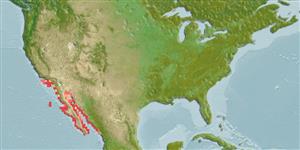>
Eupercaria/misc (Various families in series Eupercaria) >
Labridae (Wrasses) > Corinae
Etymology: Halichoeres: Greek, als, alis = salt + Greek, choiros = pig (Ref. 45335).
More on author: Ayres.
Environment: milieu / climate zone / depth range / distribution range
Écologie
marin récifal; profondeur 0 - 24 m (Ref. 2850). Subtropical; 34°N - 23°N, 121°W - 106°W
Eastern Pacific: Point Conception in California, USA to Guadalupe Island (off north-central Baja California) and the Gulf of California in Mexico.
Taille / Poids / Âge
Maturity: Lm ? range ? - ? cm
Max length : 38.0 cm TL mâle / non sexé; (Ref. 2850); âge max. reporté: 14 années (Ref. 56049)
Found close to rocks near patches of sand and in tide pools. Dart into sand when disturbed and sleep at night buried in sand with head protruding. Feed on gastropods, small crustaceans and has been observed to pick ectoparasites from other fishes (Ref. 9311). Each individual functions first as female but changes to a male at length of about 30 cm. Pelagic spawners (Ref. 56049).
Life cycle and mating behavior
Maturité | Reproduction | Frai | Œufs | Fécondité | Larves
Pelagic spawner (Ref. 56049). Changes sex at 30 cm (Ref. 2850).
Eschmeyer, W.N., E.S. Herald and H. Hammann, 1983. A field guide to Pacific coast fishes of North America. Boston (MA, USA): Houghton Mifflin Company. xii+336 p. (Ref. 2850)
Statut dans la liste rouge de l'IUCN (Ref. 130435: Version 2024-1)
Menace pour l'homme
Harmless
Utilisations par l'homme
Pêcheries: commercial; Aquarium: Commercial
Outils
Articles particuliers
Télécharger en XML
Sources Internet
Estimates based on models
Preferred temperature (Ref.
123201): 16.7 - 24.2, mean 22.3 °C (based on 103 cells).
Phylogenetic diversity index (Ref.
82804): PD
50 = 0.5000 [Uniqueness, from 0.5 = low to 2.0 = high].
Bayesian length-weight: a=0.00977 (0.00468 - 0.02039), b=3.09 (2.92 - 3.26), in cm total length, based on LWR estimates for this Genus-body shape (Ref.
93245).
Niveau trophique (Ref.
69278): 3.3 ±0.39 se; based on food items.
Résilience (Ref.
120179): Milieu, temps minimum de doublement de population : 1,4 à 4,4 années (tm=2; tmax=14).
Fishing Vulnerability (Ref.
59153): Low to moderate vulnerability (28 of 100).
Nutrients (Ref.
124155): Calcium = 32.3 [14.8, 63.9] mg/100g; Iron = 0.591 [0.326, 1.149] mg/100g; Protein = 19.3 [16.4, 21.5] %; Omega3 = 0.195 [0.114, 0.338] g/100g; Selenium = 12.9 [6.4, 25.0] μg/100g; VitaminA = 56 [17, 229] μg/100g; Zinc = 0.922 [0.613, 1.576] mg/100g (wet weight);
